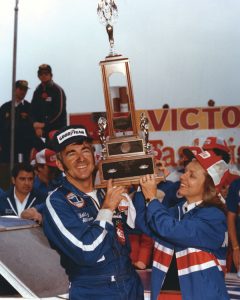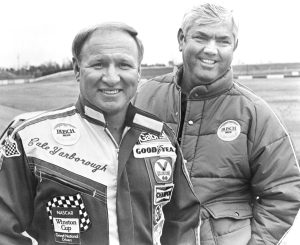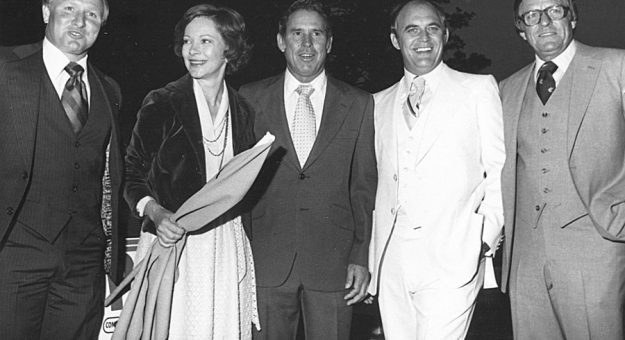Editor’s Note: NASCAR is celebrating its 75th anniversary in 2023. SPEED SPORT was founded in 1934 and was already on its way to becoming America’s Motorsports Authority when NASCAR was formed. As a result, we will bring you Part 31 of a 75-part series on the history of NASCAR as told in the pages of National Speed Sport News and SPEED SPORT Magazine.
“Racing has come a long way,” said 20-year NASCAR veteran Buddy Baker while attending a White House reception hosted by First Lady Rosalyn Carter. “I just can’t believe this.”
By 1978 NASCAR had progressed from bullrings to superspeedways, from a “southern sport” to a national one and from Daytona Beach, Fla., to the White House.
The Sept. 13 gathering found nearly 500 NASCAR drivers, owners, officials and media members on the back lawn of the White House. The guests ate on wooden picnic tables decorated with fine china and silver while country musician Willie Nelson sang. President Jimmy Carter was unable to attend because he was at Camp David negotiating a Middle East peace treaty.
Even without the president, the invitation to the nation’s capitol gave the 30-year-old race sanctioning body legitimacy outside the world of motorsports.
Sponsorship Dollars Grow
The action on the tracks became less peaceful as the purses and sponsorship dollars grew larger.
“It really was intense out there. Everybody wants to win very, very badly,” said Benny Parsons after his $11,225 victory at Richmond (Va.) Raceway. “There’s a lot of money in racing now and the sponsors expect performance.”

The increase in purse size is best illustrated with the continued growth of the winnings for the Daytona 500.
The Jan. 11 issue of National Speed Sport News reported a record $435,400 payoff for the 1978 event, up almost $46,000 over 1977. In addition, the victorious team would collect a minimum of $50,950, which exceeded the purse for the initial Daytona 500 in 1959.
“I want to do the job for (his car sponsor) First National City Travelers Checks,” Parsons added after his Feb. 26 victory in Richmond. “They’ve shown that they’ll switch drivers in a second if you don’t produce.”
The fear of losing sponsorship provided another incentive to drive well, as most drivers competed without the luxury of a big sponsor such as First National (Parsons and Cale Yarborough), STP (Richard Petty) or Gatorade (Darrell Waltrip).
Yet, new “Underdog Awards” for the World 600 at Charlotte Motor Speedway, the second Richmond race in September and the Old Dominion 500 at Martinsville (Va.) Speedway awarded additional monies to the top seven finishers who had never won a Winston Cup race.
Victors from the previous season became part of the Winston Winner’s Circle plan. Begun in 1975, the plan paid appearance money to as many as eight Winston Cup drivers who won races in either the prior or current season and pledged to run all 30 events.
In 1978, the six race winners from 1977 — Bobby Allison, Neil Bonnett, Parsons, Petty, Waltrip and Yarborough — were paid $3,500 each to appear at each of the 20 superspeedway races and $2,500 for each of the 10 short-track events.
Waltrip Frustrated With DiGard
Despite more money, some of which came from television contracts with CBS and ABC, not everyone was happy.
“I’m getting paid now as if I was just starting,” said Waltrip, whose contract with the DiGard team ran through 1982. “There’s 12 more races left in 1978 and I’ll be driving all of them for DiGard. I don’t know what 1979 will hold.”
Waltrip wanted more money and threatened to leave the DiGard team for the WIN team, taking his Gatorade sponsorship with him. DiGard President Bill Gardner reportedly wanted to match WIN’s offer to Waltrip, but when he refused, Gardner offered to sell Waltrip’s rights to WIN for “several hundred thousand dollars.”
Unable to get out of his contract, Waltrip issued a pointed explanation for his desire to leave DiGard: “I’m not as greedy as it appears,” he said in the Aug. 16 NSSN. “I haven’t been too happy with the management. I have no qualms with the crew or sponsor. It’s just that there is something to be desired when it comes to the structure of the company.”
NASCAR’s two-time and defending champion, Yarborough, was not about to relinquish his crown. Yarborough, who raced with a new car (a 1977 Oldsmobile 442 Cutlass) and a new primary sponsor (First National) in 1978, picked up where he left off in 1977, winning the 500-kilometer race at Riverside (Calif.) Int’l Raceway.
Yarborough’s victory was the 50th of his career and was the first by an Oldsmobile since Lee Petty won in Charlotte, N.C. on May 22, 1959. Yarborough and his Junior Johnson-led team defended their Daytona 500 victory, but finished second to Bobby Allison while battling handling problems with the Oldsmobile.
“It can’t hardly hold the race track,” Yarborough said after the race.
Yarborough, who had praised the combination 442 body and Chevrolet engine setup after his Riverside triumph as “quite a race car,” fell victim to the high winds which always play a role at Daytona Int’l Speedway and to the large rear window in the Oldsmobile which disrupted the airflow over the car.
Petty Struggles In New Ride
Meanwhile, six-time titlist Petty was struggling in his new ride.
Under 1978 rules, only 1976-’78 models were eligible for Winston Cup competition, eliminating the 1974 Dodge Charger in which he had earned two titles and 31 victories over four seasons.
Petty drove the Charger for the final time at Riverside and earned a 16th-place finish.

Nevertheless, Petty’s struggles in the latter half of 1977 indicated a change was needed and the Petty Enterprises team felt the Dodge Magnum would be a good race car, even if it was not the smaller Diplomat they had lobbied NASCAR to use. But when Petty started a Dodge Magnum in the Daytona 500, that is when his troubles began.
After a blown tire and subsequent accident eliminated Petty while leading the 500, the Magnum failed to finish three of the next four races en route to six DNFs in the 18 races Petty drove the car.
After the fifth DNF in July’s Nashville Fairgrounds event, Petty made the decision to use his own money and switch to a Chevrolet Monte Carlo after the Aug. 6 race at Talladega (Ala.) Superspeedway.
The Petty team never found the right setup for the boxy Magnum and recorded only seven top-five finishes with the car.
By the time his rival changed cars, Yarborough had won five races and sat atop the point standings. In perhaps his most dominant season, Yarborough won 10 times, including a wire-to-wire victory at Nashville, a triumph in the first race under the lights at Bristol (Tenn.) Motor Speedway and the Southern 500 at Darlington (S.C.) Raceway.
Yarborough led 28 of the 30 races he started en route to a record third consecutive Winston Cup title.
Bobby Allison ended a 67-race winless streak with his Daytona 500 victory and added four more victories in his Ford Thunderbird in finishing second in the standings. Waltrip also posted a fine season with six victories and, notably, Terry Labonte earned a fourth-place finish in the Southern 500 in his first Winston Cup start. He finished with three top 10s in his five starts.
NASCAR’s other titlists were Butch Lindley in the Late Model Sportsman division, Richie Evans in the National Modified division, Jimmy Insolo in Winston West competition and Larry Hoopaugh in the Baby Grand field.
Ronnie Thomas was named the First National City Travelers Checks Rookie of The Year.
